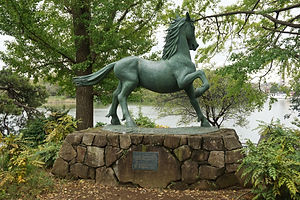普通の外にいくつかの著名な品質を持っている、と畏敬の念を起こさせるあるいかなるビーイングは、カミと呼ばれています。
Nearest station
Senzoku-Ike (IK27)
Tōkyū Ikegami Line
Tōkyō-to, Ōta-ku, Minami Senzoku 2-23-10
東京都大田区南千束2-23-10
千束八幡神社
Senzoku Hachiman Jinja
Home page: none
October 25, 2019
History
Formal name is Hachiman Jinja. Founded in 860, year two of the Jōgan Period (貞観, 859-878) as the tutelary kami for what was then the Senzoku district with the enshrinement of the Usa Hachiman-Gū kami through the kanjō process. In 935, year five of the Jōhei Period ( 承平, (931-938). when Taira Masakado began the first of the military confrontations which would lead to the Tengyo-no-ran of 939 and his death in 940, the central government in Kyōto despatched Fujiwara Tadakata in the role of Chinjufu-shōgun to deal with the situation. After the Masakado Incident Tadakata built an estate near Lake Ikegami, now Senzoku-ike (Sengoku Lake), and recognized the shrine as the home of the area’s tutelary kami.
It is said that a 9th generation descendant of his, Ikegami
Enshrined Kami:
Main
Hondawake-no-mikoto 誉田別命
From Merged Shrines
None
In-ground Shrines:
稲荷神社 Inari Jinja
神明社 Shinmei Sha
Annual Festival: Nearest Saturday/Sunday to September 7


Saemon-taifu, 池上左衛門大夫 (also known as Ikegami Yasumitsu) invited Nichiren to visit from Minobu in what is now Yamanashi-ken. In 1180 Minamoto Yoritomo was defeated at the Battle of Ishibashiyama and attempted to flee back to Kamakura. On the way he stopped at Senzoku Hachiman and was able to rally some forces there. One night when a bright moon was sparkling on the surface of Lake Ikegami a wild black horse appeared from nowhere. It was quickly captured and presented to Yoritomo. The moonlight was reflected off its skin just as it was off the lake surface and for this reason it was given the name Ikezuka (池月, lit. Lame Moon). Yoritomo was of course already the owner of one renowned horse, Surusumi (磨墨), and he interpreted the acquisition of Ikezuka as an omen that he would in due course defeat the Taira.
Description
Situated on the north-eastern bank of Senzoku-ike, a pleasant 650m walk from Senzokuike Station. Although the shrine does have a long history the main hall was built as relatively recently as 1942. The koma-inu date to 1837.
(Click on images to expand them)



















